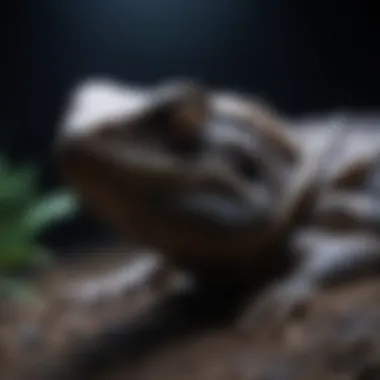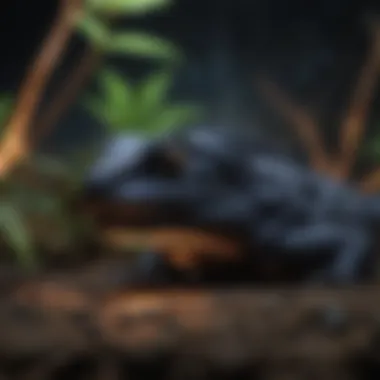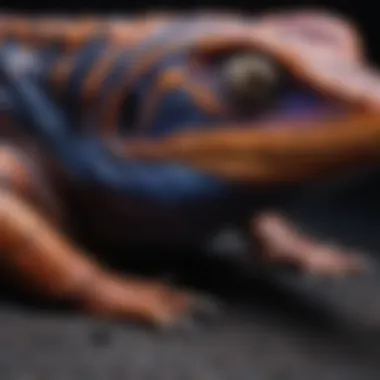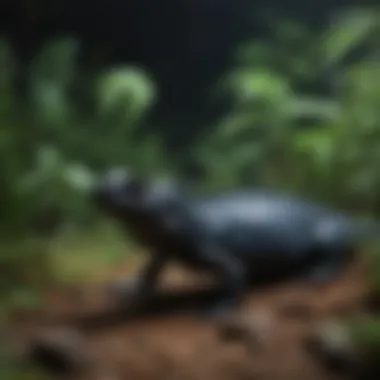Understanding the Benefits of Black Light in Reptile Care


Intro
Black light serves a fundamental role in the care of reptiles, offering multiple benefits closely aligned with their biological needs. Unlike other forms of lighting, black light does more than merely illuminate a habitat; it enhances the overall visibility and interaction with their environment. Understanding the significance of black light is essential for any reptile owner aiming to create an optimal thriving space for their pets.
Reptiles are ectothermic creatures, meaning they rely on external heat sources to regulate their body temperature. This aspect makes basking crucial for their health. Black light contributes by providing the necessary warmth and by mimicking the natural sunlight they would seek in their original habitats. Moreover, the specific wavelengths emitted by black lights can reveal details about reptile patterns and colors, which would otherwise be invisible under normal lighting conditions.
This article will guide you through various aspects of employing black light in your reptile care routine. It will cover care tips, behavioral insights, nutrition guides, wellness and health considerations, and enriching activities specifically designed to enhance the life quality of your reptiles. By understanding these components, the reptile owner can foster a more suitable habitat and improve the well-being of their animals.
Understanding Reptiles and Their Environment
Understanding the environment in which reptiles thrive is crucial for anyone involved in their care. Reptiles are ectothermic, meaning they depend on external heat sources to regulate their body temperature. Thus, the right habitat is not only important for their health but also for their overall behavior and well-being. The way light interacts with their environment plays a significant role in shaping their daily activities, metabolism, and even breeding behaviors.
Habitats and Natural Light Conditions
Reptiles inhabit diverse environments ranging from deserts to rainforests. This variation determines their exposure to natural light, influencing their physiological and behavioral adaptations. For example, desert reptiles are accustomed to bright, harsh sunlight, while those from tropical rainforests usually experience dappled light filtered through dense canopy. The understanding of these natural light conditions is vital. It allows reptile owners to mimic these conditions within terrariums or enclosures.
Correct lighting, including black light, can recreate aspects of their natural habitat, facilitate basking, and encourage active foraging behaviors. Failure to replicate these conditions could lead to stress, malnutrition, or health issues.
The Role of Light in Reptile Physiology
Light serves multiple purposes in reptile physiology. It is essential for processes such as thermoregulation, vitamin D3 synthesis, and circadian rhythms. The presence of natural light conditions affects how reptiles manage their body temperatures. Also, ultraviolet (UV) light is necessary for the synthesis of vitamin D3, which is critical in calcium metabolism.
The provision of appropriate lighting not only helps meet their physiological needs but also stimulates natural behaviors. For example, reptiles use light to gauge the time of day, which in turn influences their activity levels and feeding habits. Understanding these aspects of reptile physiology is key to promoting a healthy lifestyle for pet reptiles.
"Recreating natural light conditions in an enclosure is as important as maintaining temperature and humidity levels to support reptile health."
Intro to Black Light in Reptile Care
What is Black Light?
Black light, often known as ultraviolet (UV) light, emits light that is not visible to the human eye. Instead of the bright, visible spectrum produced by standard light bulbs, black light focuses on emitting ultraviolet radiation, primarily in the UV-A range. Reptiles use UV light for various biological functions, including vitamin D synthesis, which is vital for proper calcium metabolism and bone health. Through black light, reptiles can more closely experience conditions found in their natural habitats.
"Understanding how reptiles interact with their environment is crucial for their care. Black light contributes significantly to replicating conditions that ensure their health."
When selecting black lights for reptile care, it is important to consider both the wavelength and intensity. Not all black lights are the same; different devices emit varying levels of UV radiation that impact reptiles in distinct ways.
How Black Light Differs from Other Light Sources
Black light is distinct in several fundamental ways compared to conventional light sources. Regular bulbs primarily produce light in the visible spectrum and, in some cases, generate heat. In contrast, black light limits visible spectrum output while maximizing ultraviolet radiation. This feature is crucial for reptiles which benefit from UV exposure without the excess heat that other types of bulbs can generate.
Key differences include:
- Emission Spectrum: Black light is calibrated to release UV radiation, while standard light sources do not provide sufficient UV illumination for reptiles.
- Purpose: Standard lights serve general illumination needs but do not meet reptiles' physiological requirements. Black light serves a specific purpose in promoting health through UV exposure.
- Heat Output: Regular bulbs may create excessive heat, while black lights are designed to minimize this effect, preserving a stable environment.
In summary, black light plays a vital role in supporting the physiological needs of reptiles. Its applicability unfolds further in the following sections, detailing benefits and recommended practices for effective use in reptile habitats.
Benefits of Black Light for Reptiles


Understanding the benefits of black light for reptiles is crucial for proper care. Black light plays a significant role in replicating natural conditions, which can affect the health and behavior of reptiles. It can enhance visibility, support basking behavior, and encourage natural instincts. Each of these benefits contributes to creating a suitable habitat for reptiles, allowing them to thrive in captivity.
Enhancing Visibility
One of the primary benefits of using black light in reptile habitats is enhancing visibility. Reptiles often exhibit various patterns and colors that are difficult to see under regular lighting. Black light emits ultraviolet (UV) radiation, which many reptiles can see. This visibility is not just for the aesthetics; it can help owners observe their pets easily. By using black light, the subtle colors of the skin and markings of the reptiles are better showcased, making it easier to notice any changes in their appearance that may indicate health issues.
Aiding in Basking Behavior
Basking is essential for cold-blooded reptiles. They rely on external heat sources to regulate their body temperature. Black light closely mimics the effects of sunlight, providing necessary warmth and UV radiation. This combination encourages natural basking behavior, allowing reptiles to soak up heat and enhance their metabolic processes. Proper basking conditions can improve digestion and overall health, which is vital for reptiles kept in captivity. Each species has specific temperature needs, so owners should adjust the positioning and intensity of black lights accordingly.
Supporting Natural Behaviors
In the wild, reptiles experience various light conditions throughout the day and night. Black light helps in replicating these conditions, which supports their natural behaviors. For instance, some reptiles are more active during dusk or dawn. Providing black light can mimic this environment, enabling reptiles to engage in hunting, foraging, or socializing behaviors. This not only keeps them physically active but also mentally stimulated, which benefits their overall well-being. In this way, black light contributes significantly to the quality of life for reptiles, reducing stress and encouraging natural activity.
"Creating a conducive environment for reptiles ensures they exhibit natural behaviors and maintain their health."
In summary, the benefits of black light in reptile care are multifaceted. This lighting not only enhances visibility but also aids in basking behavior and supports the natural instincts of these animals. Understanding these benefits is essential for any reptile owner looking to provide the best possible care.
Types of Black Lights for Reptile Environments
Understanding the different types of black lights is critical for effective reptile care. Each type of black light serves distinct functions and can affect the health and behavior of reptiles in varied ways. Choosing the right type ensures that reptiles receive optimal light exposure, which can help simulate their natural habitats. This section provides an overview of the primary types of black lights available, their respective benefits, and important considerations for use.
Fluorescent vs. LED Black Lights
Fluorescent and LED black lights are the two most common options for reptile owners. Each type has its advantages.
Fluorescent black lights produce a softer glow that can be beneficial for species that require lower levels of UV radiation. They are often more affordable and widely available. However, they may need replacing approximately every six months as their effectiveness diminishes over time.
LED black lights, on the other hand, are more energy-efficient and have a longer lifespan than fluorescent lights. They emit targeted wavelengths and often provide a more intense output of UVB rays. Although they may come with a higher initial cost, their longevity makes them a more economical choice in the long run.
When deciding between these options, consider factors like the specific needs of the reptile species, the lighting layout of the habitat, and budget constraints.
UVB and its Importance
UVB light is crucial for reptiles, profoundly impacting their health and behavior. Reptiles rely on UVB to synthesize Vitamin D3, which facilitates calcium absorption. Without sufficient UVB exposure, animals can develop metabolic bone disease, a serious and potentially fatal condition.
Natural sunlight provides a full spectrum of UV radiation, and replicating this environment indoors is key. Special UVB black lights can be selected to cater to the needs of various reptiles, from desert species that bask in direct sunlight to forest-dwelling species that require filtered light.
It is essential to choose the correct UVB output based on the specific species being cared for. For instance, species like iguanas thrive under higher UVB levels, whereas others may require lower intensity.
Heat Generation and Its Effects
Heat is another important aspect of black lights in reptile habitats. Many black light sources, especially those with UVB output, generate heat. This heat can help create a suitable temperature gradient within the enclosure, important for reptiles to regulate their body temperature effectively.
However, excessive heat can lead to stress or heat-related health issues in reptiles. Monitoring temperature levels is essential when using a black light. Thermometers should be placed at various points in the habitat to ensure that areas are within safe limits for the specific species.
In summation, selecting the appropriate types of black lights is vital for the health and well-being of reptiles. Understanding the differences between fluorescent and LED options, recognizing the significance of UVB, and managing heat output are some of the factors to consider. Keeping these elements in mind can make a significant contribution to creating an optimal, enriched environment.
Best Practices for Using Black Light


Using black light effectively is crucial for ensuring the well-being of reptiles. Proper usage enhances their natural behaviors, encourages basking, and supports their overall health. The following best practices will guide reptile owners in maximizing the benefits of black light while ensuring safety.
Positioning the Light
The placement of the black light is vital. Ideally, it should be positioned above or near the basking area, where reptiles can absorb its benefits directly. Ensure that the light does not create overly hot spots, which may lead to heat stress. The distance from the reptiles should be considered; generally, 12 to 18 inches is appropriate, but this may vary by species. It is wise to observe how your reptile responds and adjust accordingly. Positioning should also account for their natural behavior. For example, arboreal species may require lights placed higher to mimic sunlight filtering through foliage.
Duration of Exposure
Creating a schedule for light exposure is essential. Reptiles need a balance of light and dark to maintain their circadian rhythms. Most reptiles benefit from about 10 to 14 hours of light exposure daily. Consider integrating a timer to maintain consistency. It is critical to monitor how your reptile reacts to this schedule. Signs of discomfort may indicate too much exposure. In contrast, excessive darkness can disrupt their feeding and activity patterns. Adjust the duration based on specific species’ requirements, as some may thrive with more or less light.
Monitoring Terminology
Understanding the terminology related to black light and its effects is beneficial for effective communication and care. Familiarize yourself with terms such as UVB (Ultraviolet B), which is essential for synthesis of vitamin D3. Knowing the differences in lights, such as the distinctions between fluorescent and LED options, can help make more informed decisions. Additionally, terms like photoperiod — the duration of light exposure — should be well understood to create suitable environments for your reptiles. Keeping a record of light changes and reptile behavior will aid in evaluating and adjusting practices for optimal health.
Key Takeaway: Position the black light strategically, maintain a proper duration for exposure, and be well-versed in related terminology to ensure the best practices are employed in reptile care.
Considerations for Specific Reptile Species
When caring for reptiles, understanding that different species have unique needs is crucial. Each species is adapted to its environment, and this directly influences its requirements for light, temperature, and humidity. The use of black light can drastically differ depending on whether you are dealing with desert reptiles or tropical ones.
Desert vs. Tropical Species
Desert reptiles, such as leopard geckos and bearded dragons, often thrive in bright, warm environments with minimal humidity. These species benefit from black light as it mimics the natural sunlight they would receive in their arid habitats. The ultraviolet (UV) rays from black lights assist in maintaining their metabolic health, particularly in vitamin D synthesis, essential for calcium absorption.
Conversely, tropical species like chameleons and green tree pythons require more humid conditions and moderate temperatures. Black light can easily overheat these environments if not used carefully. Therefore, it is important to assess the position of the light source and adjust the intensity. For tropical reptiles, lower wattage black lights may be suitable, as they won't disrupt the required humidity levels while still providing necessary UV exposure.
Nocturnal vs. Diurnal Behavior
Understanding whether a reptile is nocturnal or diurnal is also significant. Diurnal reptiles are active during the day and require exposure to light for basking. Black light can enhance their basking behavior while allowing for a comfortable environment where they still can regulate their body temperature effectively. An appropriate balance of heat and light helps to facilitate their natural behaviors.
In contrast, nocturnal reptiles are adapted to lower light conditions. Basking and exposure to direct black light may stress these species. For instance, leopard geckos are primarily nocturnal and excessive lighting can lead to overheating. In such cases, it's advisable to use black light sparingly or during specific times to offer an artificial dawn-dusk cycle instead.
"Tailoring the light to the specific needs of the reptile species is vital for health and well-being."
Using black light effectively in your reptile’s habitat means considering these key factors. Proper lighting not only supports visibility and basking behavior but is also essential for the overall health and well-being of your reptilian pets. Consult reliable resources for more details on which lighting suits your specific species best.
Understanding Potential Risks
In any aspect of reptile care, the wellbeing of these creatures is of utmost importance. When utilizing black light in their habitats, it is crucial to grasp potential risks. Understanding these risks can guide owners to make informed choices. The right lighting setup can enhance the living conditions for reptiles, but there are also inherent dangers that must be considered. This section will explore the consequences of overexposure to black light and the importance of managing heat levels effectively.
Overexposure and Its Consequences
One of the major concerns with black light usage is overexposure. Reptiles, like any other living organism, require balance in their environmental conditions. Excessive exposure to black light can lead to a range of health issues for reptiles.
Key points regarding overexposure include:
- Skin Damage: Just as humans can suffer from sunburn, reptiles can experience skin damage from prolonged exposure to black light. This can manifest as irritation or peeling skin, affecting their overall health.
- Stress Levels: Overexposure can add stress to reptiles. Their natural instincts may lead them to hide or avoid areas well-lit by black light, impacting their normal behavior.
- Disruption of Sleep Patterns: Providing excessive light may affect their circadian rhythms. This disruption can lead to a lack of sleep, resulting in lethargic behavior over time.
To mitigate these risks, it is important to monitor the time and environment in which your reptiles are exposed to black light. Establishing a lighting schedule is advisable. Reptiles need a day and night cycle to thrive. A well-planned exposure will ensure your reptiles maintain healthy habits.


Heat Stress and Safety Measures
Another significant aspect to consider is heat stress. Black lights can generate unintended heat. If not properly managed, this heat can pose serious risks for reptiles. Many species have specific temperature needs, and exceeding these can be harmful.
Safety measures include:
- Placement of Black Light: Positioning black lights too close to basking areas can create hotspots. It's essential to keep a safe distance to avoid overheating.
- Thermometer Usage: Regularly monitor the temperature in the enclosure. Having an accurate thermometer allows owners to track heat levels effectively.
- Providing Habitat Diversity: Implement areas with varying temperatures. This way, reptiles can choose where they feel most comfortable. It gives them control over their environment.
“Understanding the risks of overexposure and heat stress is vital for reptile care; these elements can significantly impact their health and behavior.”
Maintenance of Black Light Setup
Maintaining the black light setup is crucial in ensuring the well-being of reptiles. Regular upkeep affects not only the functionality of the lights but also the overall health of the animals. Unsanitary lighting conditions can lead to hazards like reduced visibility or harmful light exposure, which can negatively impact reptile behavior and health. Thus, maintaining black lights should be a priority for all reptile caretakers.
Cleaning and Care for Light Fixtures
Cleaning light fixtures is an essential part of maintenance. Dust and debris can accumulate on the surfaces of these fixtures, which may reduce their effectiveness. Regular cleaning can ensure that the black light emits the correct spectrum of UV light necessary for reptile physiology.
To clean light fixtures:
- Turn off the power: Safety is key when handling electrical equipment.
- Use a damp cloth: Wipe the exterior surfaces to remove accumulated dust.
- Check for any signs of wear: Look for frayed wires or burnt-out bulbs. Replace any faulty components promptly.
- Avoid harsh chemicals: These can damage the fixtures and affect their performance.
Taking care of your light fixtures not only prolongs their life but also maintains the necessary conditions for the reptiles.
Monitoring Performance and Lifespan
Regular monitoring of black light performance is vital for effective reptile care. Each type of black light has a specific lifespan, after which the output can decline, potentially leading to insufficient UV exposure for reptiles. It is crucial to monitor the intensity of the light to ensure it meets the needs of the reptiles.
A few key points to consider in monitoring performance include:
- Schedule regular checks: Monthly inspections of light output can help identify when bulbs need replacing.
- Use a UV meter: This tool can measure the intensity of UV radiation emitted from the light fixtures.
- Track the age of bulbs: Keeping a log of when lights are installed and replaced can assist in determining when they need to be changed.
Ultimately, ensuring that the black light setup is functioning at optimal levels is important for the health and well-being of the reptiles.
Closure: The Impact of Black Light on Reptile Care
As we draw our exploration of black light and its role in reptile care to a close, it is essential to emphasize the multifaceted impact that proper lighting has on the well-being of reptiles. The integration of black light into habitats increases more than just visibility; it essentially mirrors natural light dynamics and provides conducive conditions for the reptiles' health and behavioral patterns. The benefits range from enhancing visibility to promoting natural behaviors, which are essential in creating an environment that allows these creatures to thrive.
Black light, when properly utilized, offers significant advantages for both diurnal and nocturnal reptiles. It serves as a critical component in their habitat, not only supporting their physiological needs through appropriate UV exposure but also aiding in behaviors like basking and foraging. Understanding how to implement black light thoughtfully within the enclosure is crucial, considering each species has its own light and heating requirements. The key is to appreciate that black light is not merely a lighting option but an essential tool for replicating natural environments.
Therefore, reptile keepers must remain vigilant about the specific needs of their pets concerning light exposure while being mindful of associated risks, such as overexposure or heat stress. By providing a well-structured environment enriched with the right light sources, reptile enthusiasts can foster an authentic experience for their pets, leading to healthier and more active reptiles.
Summary of Benefits
The benefits of black light in reptile care are numerous, particularly in how it engages reptiles with their surroundings. Some notable advantages include:
- Enhanced visibility: Black lights allow keepers to observe their reptiles more easily, especially if they are nocturnal species. This, in turn, can aid owners in monitoring health and behavior.
- Aiding in basking behavior: Basking is a crucial natural behavior for reptiles to regulate their body temperature. Black light can mimic the sun's rays, assisting reptiles in achieving optimal temperatures.
- Supporting natural behaviors: With the right light, reptiles can exhibit behaviors similar to what they would demonstrate in their natural habitats, thereby enriching their lives and improving overall health.
- Promoting food intake: Adequate lighting enhances activity levels, which is linked to better feeding behavior. It allows reptiles to become more engaged during feeding times.
Overall, these benefits highlight the importance of incorporating black light into the habitat of reptiles, from improving visibility to supporting natural temperature regulation.
Final Recommendations
- Research Specific Needs: Understand the requirements specific to the species you own. Different reptiles have varied needs for heat and UV radiation.
- Proper Positioning: Ensure the black light is strategically placed to provide adequate basking spots. Use reflectors to increase efficiency.
- Monitor Exposure Time: Observe your reptiles for signs of stress or lethargy, which may indicate overexposure. Regular checks every few weeks can help gauge the situation.
- Consider Combined Light Sources: Depending on your reptile, combining black light with other light sources may yield better results for both visibility and heating.
- Update Regularly: Stay current with advancements in reptile lighting technology. Regular maintenance of light fixtures is also crucial for performance.
By following these recommendations, you can create an environment that ensures your reptiles can flourish, reflecting the conditions they would encounter in their natural habitats.















